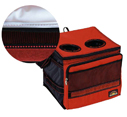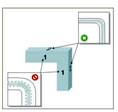| 1. |
Color Fastness |
| |
All of our color fastness-treated zippers can achieve CNS level 4 in color fastness. If there is a risk of color transfer during usage, a colorfast zipper chould be specified during ordering. Generally speaking, color transfer occurs more easily in the following situations:
1. When the zipper comes in contact with synthetic leather, PVC, adhesives, solvents, and other unknown chemicals in polyvinyl materials.
2. Extended exposure in severe environments (high temperature, high pressure, high humidity, etc.)
3. High contrast usage (dark zipper on white or light colored base), especially when there are residual chemicals on the base material. |
| 2. |
Material-Black Zipper |
| |
A material-black zipper is made directly from black materials, instead of being dyed black from a white zipper. Therefore, its color is darker than a color fastness-treated zipper, and its cost is higher as well. In especially severe environments (as shown, black zipper on a white PVC base in a thermo bag) where a dark black is required, we suggest using a material-black zipper. |
 |
| Click to examine |
| 3. |
Material-White Zipper |
| |
A material-white zipper is manufactured without being dyed. We suggest using a material-white zipper when there is no special need for color to save cost, such as in one-time garments, blanket/comforter bags, etc. |
|
|
| |
Usage Considerations ¡@¡@¡@¡@¡@¡@¡@¡@¡@¡@¡@¡@¡@¡@¡@¡@¡@¡@¡@¡@¡@¡@¡@¡@¡@¡@ |
| 1. |
High Curvature |
| |
When zippers are used in a high curvature environment, we strongly suggest using nylon coil zippers. If plastic zippers must be used,it is advisable to use zippers with narrow teeth such as our #7 and #9 to facilitate the movement. Also, as shown in the |
 |
| illustration, a good design should avoid sharp lateral turns (such |
Click to examine |
as side 1).
Instead a vertical turn as shown in side 2 should be used. Due to the physical structure of the zipper, reverse zippers should be avoided. If a reverse zipper must be used, the safety factor must be increased significantly to ensure the product quality. |
| 2. |
High Operation Tension |
| |
If the product is to be operated (i.e., opened and closed) under high lateral tension, the design safety factor should be increased. It is also not advisable to use reverse zippers. This design consideration applies only to operation tension; after the zipper is closed, there is little difference between a standard and reverse zipper (excluding sharp turns). |
 |
| Click to examine |
| |
| 3. |
One-sided Usage |
| |
Due to the formation process, nylon zipper teeth are directional and will twist if subjected to one-sided usage. An example one-sided usage and its consequences are as illustrated. It can be considered if the usage is not long, and both sides are attached to a rigid |
 |
| material. Please contact us if you have special needs regarding one-sided usage. |
Click to examine |
| 4. |
Mix and Match |
| |
Both sides of the nylon zipper teeth are formed concurrently. After a series of manufacturing processes (sewing, dyeing, pressing, etc.), the dimensional changes are consistent between the two |
 |
| sides. Dimensional changes among different batches are not |
Click to examine |
| necessarily identical, and therefore it is not recommended that the zippers ate taken apart and used in a mix and match fashion to avoid differences. Plastic zippers curvature (as illustrated) and length differences. Plastic zippers are injection molded and are not subject to this mix and match restriction. |
| 5. |
Out-of-plane Usage |
| |
Out-of-plane usage is when the zipper tape and teeth are on different planes after the zipper has been closed (as illustrated). Nylon zippers can be used in an out-of plane fashion if the teeth are facing outward (standard configuation), while a reverse |
 |
| configuration is not recommended. Plastic zipper teeth are |
Click to examine |
| independently formed on each tooth is not guided by the previous tooth. When used in an out-of-plane configuration, it is prone to getting stuck, operation difficulty, and under brute force even dislocation of teeth. Therefore, it is not advisable to use plastic zippers in an out-of-plane configuration. |
| 6. |
Overly Tight |
| |
When the zipper is sewn too close to the surrounding material, and there is interference between the material and slider (as illustrated), the smoothness of operation will be impaired. The |
 |
| friction is especially large when the zipper is sewn without |
Click to examine |
| clearance between two rigid materials, which leads to a larger operation force and possible abrasion or stripping of the slider finish. Usually a widened tape zipper can alleviate this type of problem. |
| |
Top |



